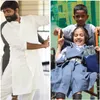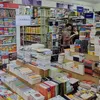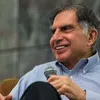Design, art, culture: National Museum of Qatar brings heritage to life through immersive experiences
In our three-part photo essay from Doha, we showcase spectacular museum design and art exhibitions.
Launched in 2014, PhotoSparks is a weekly feature from YourStory, with photographs that celebrate the spirit of creativity and innovation. In the earlier 820 posts, we featured an art festival, cartoon gallery. world music festival, telecom expo, millets fair, climate change expo, wildlife conference, startup festival, Diwali rangoli, and jazz festival.
Founded in 2005, Qatar Museums has overseen the development of the National Museum of Qatar, Museum of Islamic Art, Arab Museum of Modern Art, and Qatar Olympic and Sports Museum. Upcoming initiatives include Qatar Auto Museum and Art Mill Museum.

Unveiled to the public in 2019, the National Museum of Qatar has a spectacular design inspired by a crystal formation called the desert rose. The unique design is crafted by French architect Jean Nouvel.
“Qatar has a deep rapport with the desert, with its flora and fauna, its nomadic people, its long traditions,” Jean Nouvel describes (watch the back-story video here).
“To fuse these contrasting stories, I needed a symbolic element. Eventually, I remembered the phenomenon of the desert rose: crystalline forms, like miniature architectural events, that emerge from the ground through the work of wind, salt water, and sand,” he adds.

The museum has 11 galleries that bring alive the story of Qatar, using inspirational design approaches and narrative techniques. Connections between people, land, sea, habitat, and industry are depicted through immersive experiences of sight, sound and even aroma.
Many galleries showcase films by award-winning international directors and produced by the Doha Film Institute. They include Jaques Perrin, Mira Nair, Christophe Cheysson, Jananne Al-Ani, Abderrahmane Sissako, and John Sanborn.
The films cover the entire curved wall in many of the galleries, with surround sound. They transport visitors right into the worlds represented by the displayed objects and posters, making for memorable experiences.

The museum’s first gallery narrates the story of the region of Qatar from more than 700 million years ago, with models of flora and fauna. Many of the land and sea creatures are now extinct.
The exhibits describe the geological processes that created the Qatari peninsula, with the second gallery focusing on the natural environment. The third gallery showcases the archaeology of Qatar, right from the days of camps to prosperous towns.
There are around a thousand artefacts displayed in mounted form in glass cases. They showcase archaeological sites and reconstruction of rites like burial.

The next two galleries feature life in the desert (al barr), movements towards the coast, and the quest for water and pastures. The challenges of the harsh environment required strong community bonds, which were captured and transferred across generations through traditions such as textiles and poetry.
Visuals and films about desert encampments are accompanied by the sound of the wind moving with sand. The coastal exhibits depict interactions of local communities with traders from Europe and India, and activities around boats, fish and pearls.
Pearls have been harvested for centuries in the waters around Qatar, as shown in exhibits of pearl sorting equipment, jewellery pieces, and the Baroda carpet (a covering for the tomb of the Prophet Mohammed). Made in India, the carpet is adorned with Gulf seed pearls.

The narrative in the next galleries switches to the modern times, with exhibits on national building, the rise of the oil industry, and regional politics. The final section narrates the work on economic diversification and building resilience among youth.
An ongoing exhibition in one of the galleries is Art Mill Museum’s MANZAR: Art and Architecture from Pakistan 1940s to Today. The apt name ‘manzar’ means a view or perspective.
The exhibition is curated by Caroline Hancock, Aurélien Lemonier, and Zarmeene Shah. The showcase is designed by architect Raza Ali Dada.

The catalogue is designed by Kiran Ahmad, and includes essays on art and architecture. Featured artists include Ali Kazim, Zainul Abedin, Samya Arif, Durriya Kazi, and Ruby Chishti.
Other sections of the museum cluster feature the Museum Park, with a selection of native Qatari plants. A journey through Morocco’s heritage is showcased in the exhibition Splendours of the Atlas.
Qatar Museums has also overseen public art installations in prominent locations by a range of artists. They include Bashayer Al-Badr, Shilpa Gupta, Salman Al-Malek, Franz West, Ernesto Neto, Suki Seokyeong Kang, Monira Al Qadiri, and Simone Fattal.
Other creative initiatives are M7 (hub for startups in fashion, design and tech), Liwan (design studios and labs), Taswer (photographic practices), Music Lab, Fire Station (artist in residence), and the Design Doha bienniale.
Now what have you done today to pause in your busy schedule and harness your creative side for a better world?















(All photographs were taken by Madanmohan Rao on location in Doha.)
Edited by Swetha Kannan












